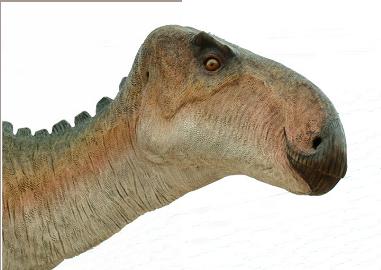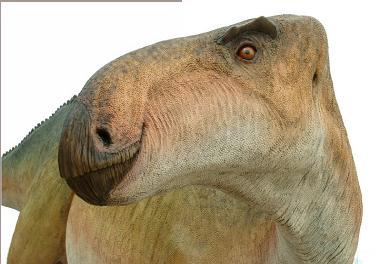click images for larger views

Iguanodon was a plant-eating dinosaur that had a conical spike on each thumb. This 30-foot-long dinosaur lived during the early Cretaceous period, about 135 to 125 million years ago and may have lived in herds. Iguanodon was the second dinosaur discovered.
Anatomy: Iguanodon was a dinosaur that had a horny, toothless beak and tightly-packed cheek teeth. On each hand, Iguanodon had four fingers plus a conical thumb spike on each hand (that was perpendicular to the other fingers). The thumb spikes may have been used for defense or in obtaining food. Iguanodon had a flat, stiff tail and three-toed hind feet with hoof-like claws. Its legs were much larger than its arms.
Fossils and Name: Iguanodon was named by Gideon A. Mantell in 1825. Mantell recognized the similarity between Iguanodon's tooth and that of the modern iguana, except the Iguanodon's was much larger. Iguanodon was the second dinosaur fossil named, and Mantell named it Iguanodon, meaning "iguana tooth." Hundreds of Iguanodon fossils have been found around the world, especially in Belgium, England, Germany, North Africa, and the USA. The type species, I. anglicum, was named by Holl in 1829.
Anatomy: Iguanodon was a dinosaur that had a horny, toothless beak and tightly-packed cheek teeth. On each hand, Iguanodon had four fingers plus a conical thumb spike on each hand (that was perpendicular to the other fingers). The thumb spikes may have been used for defense or in obtaining food. Iguanodon had a flat, stiff tail and three-toed hind feet with hoof-like claws. Its legs were much larger than its arms.
Fossils and Name: Iguanodon was named by Gideon A. Mantell in 1825. Mantell recognized the similarity between Iguanodon's tooth and that of the modern iguana, except the Iguanodon's was much larger. Iguanodon was the second dinosaur fossil named, and Mantell named it Iguanodon, meaning "iguana tooth." Hundreds of Iguanodon fossils have been found around the world, especially in Belgium, England, Germany, North Africa, and the USA. The type species, I. anglicum, was named by Holl in 1829.
[[Home]
[News] [Life-Size Sculptures] [Model Kits] [Wildlife Collection]
[Complete Catalog]
[About Us] [Contact Us]
[Frequent Questions] [The Studio At Work] [Links] [Privacy Policy] [Terms of Use]
mail@cmstudio.com
© 2017 CM Studio
All Rights Reserved
CM Studio 100 West Central Avenue Benld, Illinois 62009
[News] [Life-Size Sculptures] [Model Kits] [Wildlife Collection]
[Complete Catalog]
[About Us] [Contact Us]
[Frequent Questions] [The Studio At Work] [Links] [Privacy Policy] [Terms of Use]
mail@cmstudio.com
© 2017 CM Studio
All Rights Reserved
CM Studio 100 West Central Avenue Benld, Illinois 62009



